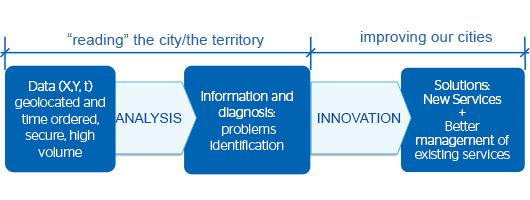Is a city an entity that can be analyzed using scientific methods? Are urban dynamics suitable for numerical analysis? The answer may be: yes and no.
Without question, physically a city in itself is a technological product, an engineering feat, designed on drawings, marked out and measured in terms of length, surface area, volume and resources. As regards the physical infrastructures that keep the urban metabolism operating, there is no doubt as to the need for measuring in order to know, to compare, identifying best practices to be replicated, and also areas for improvement. In this way, evaluation systems arise which, just to give one example, enable the European Commission to choose the green European capital (at present Nantes, Vitoria last year), considering the following aspects:
- Mitigation of and adaptation to climate change
- Energy efficiency
- Urban transport
- Efficient management of the water cycle (supply and sanitation)
- Efficient waste generation and management
- Air quality
- Acoustic quality of the environment
- Eco-innovation and its use in sectors associated with sustainability
- Green spaces and sustainable use of land
- Nature and biodiversity
- Integrated environment management
But the physical plane is just one very partial aspect of a city. The most complex interactions, namely socioeconomic, take place on this plane. It is a mere support for meeting the needs of citizens, and these are certainly the true protagonists of urban life. It is society that needs to focus the debate on smart cities, not the technological tools that enable us to better understand the interactions between the physical and social planes.
This said, we can reformulate the initial question: is urban sociology incompatible with the use of indicators and, therefore, with deterministic philosophy? Here, the answer cannot be as emphatic as in the previous case. When we talk about interactions among people, cultural, educational, social and economic nuances need to be considered. On the one hand, we should be cautious when applying the scientific method to social dynamics, as José Luis Sampedro recommended in this article “el reloj, el gato y Madagascar” (the clock, the cat and Madagascar), which remains as valid today as it was 30 years ago when it was written, but on the other hand, we should not reject (nor deny) the new opportunities afforded by the scientific and technical development we have achieved.
The growing interconnection between all the agents, citizens included, and our current capabilities, especially in the area of processing vast amounts of data, enables us to interpret what is happening in the territory from new points of view. Technology puts within our grasp visions that until recently we could not even imagine. Even aspects of subjective perception, which a priori are difficult to measure and reflect using numerical indicators, are discovered today and made available to those who are willing to step in to improve our society: governments, universities and research centers, corporations, the media and, of course, citizens.

In short, today we have new instruments for identifying problems and opportunities, and for proposing solutions within the framework of the classic goals of urban planning, such as proper management of transport systems, planning and design of new expansion areas, or the restoration of rundown environments, revitalizing the economy, setting up new services, promoting citizen involvement, and the communication and management of incidents and proposals. Issues that in the past were solved by planners and managers by using surveys, interviews or manual counts can now be solved through the analysis of large volumes of data, reaching conclusions that are no longer partial nor static.
There will always be aspects that cannot be tackled using mathematical methods, but we should not miss the chances afforded by scientific analysis if it can improve our understanding of the systems that make up a city.
Juan Murillo
Urbanist and Big Data Manager, BBVA Innovation Center, Madrid (Spain)
Comments on this publication